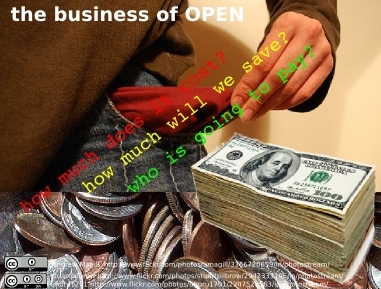OER benefits and myths
| [▲]Course dashboard for #OCL4Ed | ||
|---|---|---|
| Educators care: Why open matters? Part 2 | Video Signpost - David Wiley | Ownership of ideas | Defining OER | OER benefits and myths | Summary and activity | 2nd Learning reflection | |
| “ | In a time of drastic change it is the learners who inherit the future. The learned usually find themselves equipped to live in a world that no longer exists. | ” |
| —Eric Hoffer, 1973 | ||
In education, prior to 1946, there were no single-mode distance teaching universities. However, the technology of moveable type and universal postal services resulted in the phenomenal expansion of the large-scale single-mode distance teaching universities around the world. It is plausible that OER can repeat the history of open distance learning and engineer new forms of delivery widening access to learning for all students.
We are at the crossroads of a quantum shift opportunity to provide free learning to all students of the world utilising the power of the open web combined with open content licensing. For example, the OER university network, an innovation partnership of 13 founding anchor partners, will open pathways for informal OER learners to earn formal academic credit and pay reduced fees for assessment and credit utilising open content models. This could lead to the establishment of an "OER university" to co-ordinate and facilitate access to free learning for all learners of the world.
The economic fundamentals of OER are sound and the rhetorical myths frequently cited against open education strategies do not hold up against rational analysis.
Benefits of OER
| “ | OER is the means by which education at all levels can be more accessible, more affordable and more efficient. | ” |
| —Phil Ker, Chief Executive, Otago Polytechnic[1] | ||
- The direct cost per institution of developing high quality learning materials released under open content licenses is cheaper when shared across multiple institutions, when compared to the cost of doing this alone.
- OER provides unique opportunities for all institutions to diversify curriculum offerings especially for low enrolment courses in a cost-effective way. Using OER approaches means that teaching institutions do not need to commit the variable costs of teaching low enrolment courses in the absence of confirmed student registrations.
- Open textbooks will reduce the cost of study for learners. The Student Public Interest Research Groups (PIRGs) report that open textbooks can reduce the average amount spent by 80%.[2]
In a digital world where the marginal cost of replicating digital knowledge is near zero, the systemic benefits of sharing the costs of production are indisputable.
The institutional advantages of OER extend beyond economic benefits. The Open University, for instance, reports on the following benefits of the OpenLearn project [3]:
- Enhancing the reputation of The Open University
- Extending reach to new users and communities
- Recruitment of students
- Supporting widening participation
- Providing an experimental base of material for use within the university
- Accelerating uptake and use of new technologies
- Acting as a catalyst for less formal collaborations and partnerships.
Myths and red herrings
It is not unusual at times of radical innovation precipitated by new technology for institutions to become creative in defending entrenched technologies. Consider for example the case of the ice harvesting industry where harvested "natural" ice was replaced with "artificial" ice production.[4] In the late 1800s, the ice harvesting industry ranked with grain production as a major component of the gross domestic product in the United States, until it was replaced by electrical production of ice. Frequently new technologies are viewed as crude and proponents of existing technologies will be quick to highlight poor performance of maturing new technologies in attempts to maintain the status quo. During this time of change, red herrings are frequently introduced into the discourse.
| Red herring is an idiomatic expression referring to the rhetorical or literary tactic of diverting attention away from an item of significance. This extract is licensed under the Creative Commons Attribution-ShareAlike license. It uses material from the article "Red herring", retrieved 31 December 2010. |
The two most prevalent red herrings associated with OER are:
- The sky will fall down. This myth intimates that education institutions will lose competitive advantage and student enrolment, if their course materials are released under open content licenses. To date, there is no substantive research base which validates this assertion. On the contrary there is growing evidence that opening course materials to informal learners does to lead to the recruitment of formerly registered students. In the case of The Open University, McAndrew and Lane report that 10,500 students made use of the OpenLearn site before registering for an official course.[3] The preferred prescribed texts used by education institutions are unlikely to be a major decision-driver for learners when deciding on registering for a course. Moreover, if education institutions are building their competitive advantage based on their closed-course materials, it is unlikely that they will be able to sustain this in the long run as more content is developed and released under open content licenses.
- The quality of OER is inferior. Should this myth be translated to mean: I'm embarrassed to share my teaching materials openly? The point is that if educators are the producers of OER, then we only have ourselves to blame for producing inferior quality materials. With reference to the quality criterion, OER does have a point of difference when compared to closed-resources, namely the freedom to improve the quality as a derivative work.
There are unquestionably barriers to the mainstream adoption of OER, including for example: restrictive intellectual property policies at our institutions; lack of time for educators to develop and remix OER; organisational incentive systems which do not encourage or reward open education activities. However, these are not myths, but allude to another problem, the challenge of strategic and decisive leadership in education.
The way forward for OER
|
Barriers, opportunities and the way forward In this discussion we invite you to share thoughts and ideas relevant to the mainstream adoption of OER in the formal education sector. Please share your thoughts using the Google+ OCL4Ed Community (or you can post on your personal course blog).
|
Notes
- Jump up ↑ Ker, P. (No Date). About Otago Polytechnic: An open education message from our Chief Executive. Retrieved 30 December 2010.
- Jump up ↑ Allen, N. (September 2010). A Cover to Cover Solution: How Open Textbooks are the Path to Textbook Affordability. The Student PIRGs. p. 5.
- ↑ Jump up to: 3.0 3.1 McAndrew, P. and Lane, A. (2010). The impact of OpenLearn: making The Open University more "Open". Association for Learning Technology: Online Newsletter, 18.
- Jump up ↑ Utterback, J. (2004). The Dynamics of Innovation. EDUCAUSE Review. 39(1).

